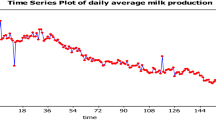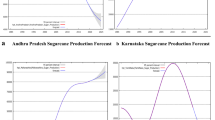Abstract
This study uses yearly data from 1961 to 2018 to forecast milk production in South Asian countries (including China) using ARIMA/GARCH models and Holt’s Linear approach. It is revealed that not all the methods are equally effective in forecasting. Comparison of mean absolute percentage errors between ARIMA and Holt’s Linear model shows that Holt’s approach reveals higher errors.ARIMA forecasting results show that India will be the country with the highest milk production, followed by Pakistan and China while GARCH model fits better to Bangladesh. This paper has policy implications as it can be used for the proper planning of dairy products in the South-Asian counties to safeguard nutritional security.


Similar content being viewed by others
References
Adediran SA, Ratkowsky DA, Donaghy DJ, Malau-Aduli AEO (2012) Comparative evaluation of a new lactation curve model for pasture-based Holstein- Friesian dairy cows. J Dairy Sci 95:5344–5356
Ahuja V, Staal S (2012) Poverty, food security, livestock and smallholders: issues and options for the Asia and the Pacific region. Asian livestock 16:97
Akter, Sh., and Rahman,S.(2010) Milk supply forecasting for a dairy cooperative in the UK using univariate time series modelling techniques, In book: Agricultural Economics: New Research (pp.227–242), Chapter:11, Publisher: Nova Science Publishers, New York, Editors: Thomas H. Lee
Ali TE, Schaeffer LR (1987) Accounting for covariances among test day milk yields in dairy cows. Can J Anim Sci 67:637–644
Baudracco J, Lopez-Villalobos N, Holmes CW, Comeron EA, Macdonald KA, Barry TN, Friggens NC (2012) e-cow: an animal model that predicts herbage intake, milk yield and live weight change in dairy cows grazing temperate pastures, with and without supplementary feeding. Animal 6:980–993
Bollerslev T (1986) Generalized autoregressive conditional heteroskedasticity. J econom 31(3):307–327
Brun-Lafleur L, Delaby L, Husson F, Faverdin P (2010) Predicting energy × protein interaction on milk yield and milk composition in dairy cows. J Dairy Sci 93:4128–4143
Collard BL, Boettcher PJ, Dekkers JCM, Petitclerc D, Schaeffer LR (2000) Relationships between energy balance and health traits of dairy cattle in early lactation. J Dairy Sci 83:2683–2690
Deshmukh SS, Paramasivam R (2016) Forecasting of milk production in India with ARIMA and VAR time series models. Asian J Dairy Food Res 35(1):17–22
FAO (2019) Food outlook, dairy market review report. Rome, Italy
FAO (2020) Food outlook, biannual report on global food markets. Italy, Rome
Grzesiak W, Lacroix R, Wójcik J, Blaszczyk P (2003) A comparison of neural network and multiple regression predictions for 305-day lactation yield using partial lactation records. Can J Anim Sci 83:307–310
Guo ZSH (1995) Modelling of the lactation curve as a sub-model in the evaluation of test day records. Prague, SverigesLantbruksuniv, Uppsala, Sweden, INTERBULL
Holt CC (1957) Forecasting seasonals and trends by exponentially weighted moving averages. ONR Memorandum, Vol 52, Carnegie Institute of Technology, Pittsburgh. Available from the Engineering Library, University of Texas, Austin
Kolver ES, Muller LD (1998) Performance and nutrient intake of high producing Holstein cows consuming pasture or a total mixed ration. J Dairy Sci 81:1403–1411
Li H (2020) Genome-wide association study of milk production traits in acrossbred dairy sheep population using three statistical models. Anim Genet 51:624–628
Lohano DH, Soomro MF (2006) Unit root test and forecast of milk production in Pakistan. Int J Dairy Sci 1(1):63–69
Macciotta NPP, Vicario D, Pulina G, Cappio-Borlino A (2002) Test day and lactation yield predictions in Italian Simmental cows by ARMA methods. J Dairy Sci 85:3107–3114
McCarthy B, Delaby L, Pierce KM, Journot F, Horan B (2011) Meta-analysis of the impact of stocking rate on the productivity of pasture-based milk production systems. Animal 5:784–794
Mishra P, Fatih C, Niranjan HK, Tiwari S, Devi M, Dubey A (2020a) Modelling and forecasting of milk production in Chhattisgarh and India. Indian J Anim Res 54(7):912–917
Mishra P, Fatih C, Vani GK, Tiwari S, Ramesh D, Dubey A (2020b) Time series investigation of milk production in major states of india using ARIMA modeling. J Anim Res 10(1):77–84
Murphy DM, Zhang F, Upton J, Shine P (2014) A review of milk production forecasting models, in book: dairy farming operations management, animal welfare and milk production, 1st edn, Nova Science Publishers, pp 14–61
Oliveros RM (2019) The Dairy industry in Southeast Asia: perspective, challenges and opportunities, earth and environmental. Science 372:1–9
Olori VE, Brotherstone S, Hill WG, McGuirk BJ (1999a) Fit of standard models ofthe lactation curve to weekly records of milk production of cows in a single herd. Livestock Prod Sci 58:55–63
Olori VE, Brotherstone S, Hill WG, McGuirk BJ (1999b) Fit of standard models of the lactation curve to weekly records of milk production of cows in a single herd. Livestock Prod Sci 58:55–63
Ptak E, Schaeffer LR (1993) Use of test day yields for genetic evaluation of dairy sires and cows. Livestock Prod Sci 34:23–34
SAARC (2015) SAARC diary outlook, March 2015
Schmit TM, Kaiser HM (2006) Forecasting fluid milk and cheese demands for the next decade. J dairy sci 89(12):4924–4936
Shalloo L, Dillon P, Rath M, Wallace M (2004) Description and validation of the Moorepark dairy system model. J Dairy Sci 87:1945–1959
Sharma AK, Sharma RK, Kasana HS (2006) Empirical comparisons of feed-forward connectionist and conventional regression models for prediction of first lactation 305-day milk yield in Karan Fries dairy cows. Neural Comput Appl 15:359–365
Sharma RK, Sharma AK, Kasana HS (2007) Prediction of first lactation 305-day milk yield in Karan Fries dairy cattle using ANN modeling. Appl Soft Comput J 7:1112–1120
Siddiky MNA (ed) (2015) SAARC dairy outlook. SAARC Agriculture Centre, Dhaka, Bangladesh
Smith LP (1968) Forecasting annual milk yields. Agricult Meteorol 5:209–214
Taye BA, Alene AA, Nega KA, Yirsaw GB (2020) Time series analysis of cow milk production at Andassa dairy farm. West Gojam Zone, Amhara Region, Ethiopia, Modeling Earth Systems and Environment, p 364
Tekerli M, Akinci Z, Dogan I, Akcan A (2000) Factors affecting the shape of lactation curves of Holstein cows from the Balikesir province of Turkey. J Dairy Sci 83:1381–1386
Uddin MM, Khaleduzzaman ABM, Akter A (2020) Sustainable dairying and self-sufficiency in quality milk production in Bangladesh: the role of policy and a way forward. Bangladesh J Acad Sci (Submitted)
Vasconcelos J, Martins A, Petim-Batista MF, Colaço J, Blake RW, Carvalheira J (2004) Prediction of daily and lactation yields of milk, fat, and protein using an autoregressive repeatability test day model. J Dairy Sci 87:2591–2598
Wilmink JBM (1987) Adjustment of test-day milk, fat and protein yield for age, season and stage of lactation. Livestock Prod Sci 16:335–348
Wood PDP (1967) Algebraic model of the lactation curve in cattle. Nature 216(5111):164–165
Zhang F, Shine P, Upton J, Shaloo L, Murphy MD (2020) A Review of Milk Production Forecasting Models: Past & Future Methods.
Acknowledgement
The work was supported by the Ministry of Science and Higher Education of the Russian Federation (government order FENU-2020-0022).
Author information
Authors and Affiliations
Corresponding author
Additional information
Publisher's Note
Springer Nature remains neutral with regard to jurisdictional claims in published maps and institutional affiliations.
Rights and permissions
About this article
Cite this article
Mishra, P., Matuka, A., Abotaleb, M.S.A. et al. Modeling and forecasting of milk production in the SAARC countries and China. Model. Earth Syst. Environ. 8, 947–959 (2022). https://doi.org/10.1007/s40808-021-01138-z
Received:
Accepted:
Published:
Issue Date:
DOI: https://doi.org/10.1007/s40808-021-01138-z




